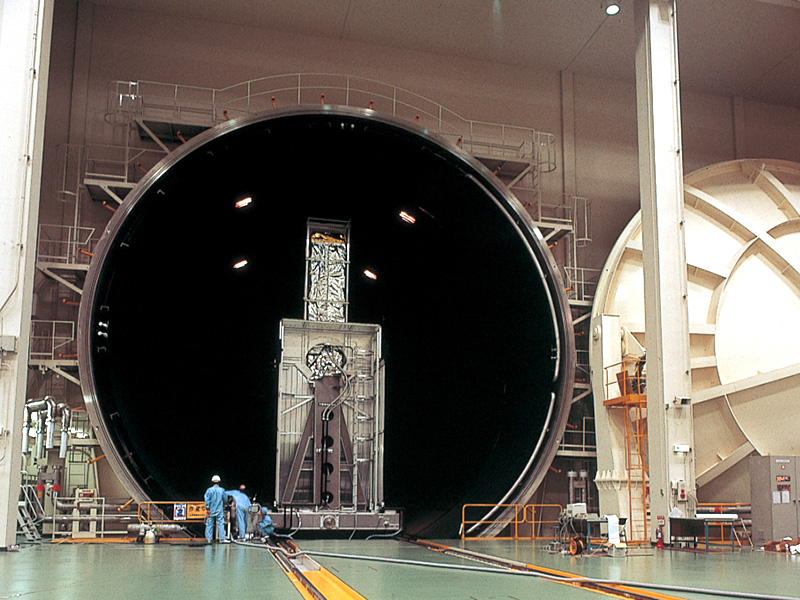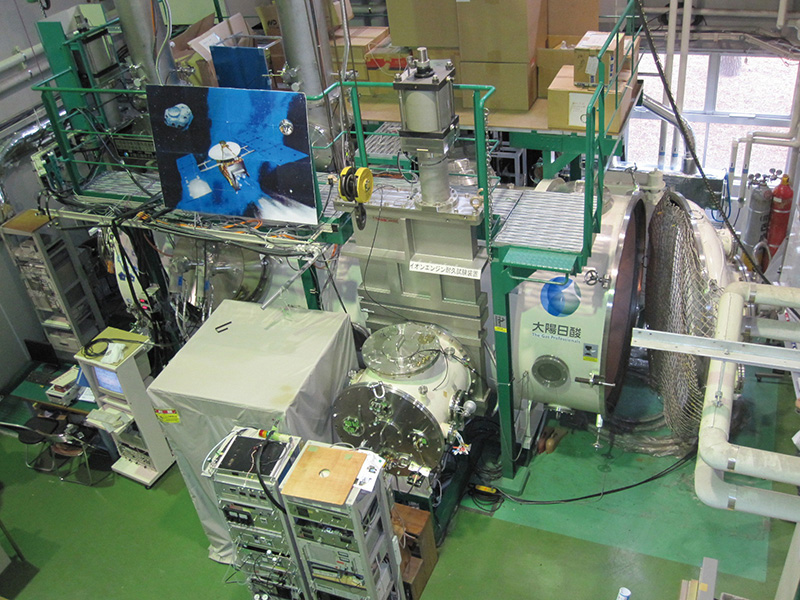The Asteroid Explorer "Hayabusa" overcame many difficulties to finish its journey of about 6 billion kilometers over 7 years. In June 2010, it brought samples from the asteroid Itokawa back to Earth.
It was the world's first attempt to take asteroid particles to Earth. The analysis of the particles resulted in discoveries of new information that may solve the mysteries of how the solar system was born.
The space chamber developed with our ultra-low temperature and high vacuum technologies was used for the long-term development testing of the propulsion ion engines used for "Hayabusa".
Space simulated on earth
Taiyo Nippon Sanso's space chambers are used to simulate space on earth.
They can closely simulate the extreme environmental conditions of space, such as low temperature, darkness, and ultra-high vacuum. We provide a wide variety of chambers from ultra-small chambers for part development testing to ultra-large chambers for entire satellites.

Large space chamber at JAXA's Tsukuba Space Center
(Courtesy of JAXA)

Apparatus for testing the endurance of electric propulsion (testing apparatus for Hayabusa's ion engines)
(Courtesy of JAXA)
Space is a cold, dark, and ultra-high-vacuum world without air.
To create a cold and dark environment, a shroud is mounted inside the space chamber, and our ultra-low-temperature technology can cool down this shroud to an ultra-low temperature of -177°C. The inside (satellite side) of this shroud is coated with special black paint that almost completely absorbs the light.
Moreover, we enable this inside surface, that has reached an ultra-low temperature, to absorb molecules and so create an ultra-high-vacuum environment. This is in addition to the vacuum emissions of the vacuum pump used to create an air-free environment.
Major satellites and probes tested in Taiyo Nippon Sanso's space chambers
-
Solar Physics Satellite "HINODE" (SOLAR-B): Launched in September 2006, currently in operation
-
Infrared Imaging Satellite "AKARI" (ASTRO-F): Launched in February 2006, operation completed
-
Mercury Magnetospheric Orbiter "MIO" (MMO): Launched in October 2018, currently in operation
-
Venus Climate Orbiter "AKATSUKI" (PLANET-C): Launched in May 2010, currently in operation
-
Small Solar Power Sail Demonstrator "IKAROS": Launched in May 2010, currently in operation
-
Selenological and Engineering Explorer "KAGUYA" (SELENE): Launched in September 2007, operation completed
-
Spectroscopic Planet Observatory for Recognition of Interaction of Atmosphere "HISAKI" (SPRINT-A): Launched in September 2013, currently in operation
-
Asteroid Explorer "Hayabusa2": Launched in December 2014, currently in operation
-
Geospace Probe "Arase" (ERG): Launched in December 2016, currently in operation